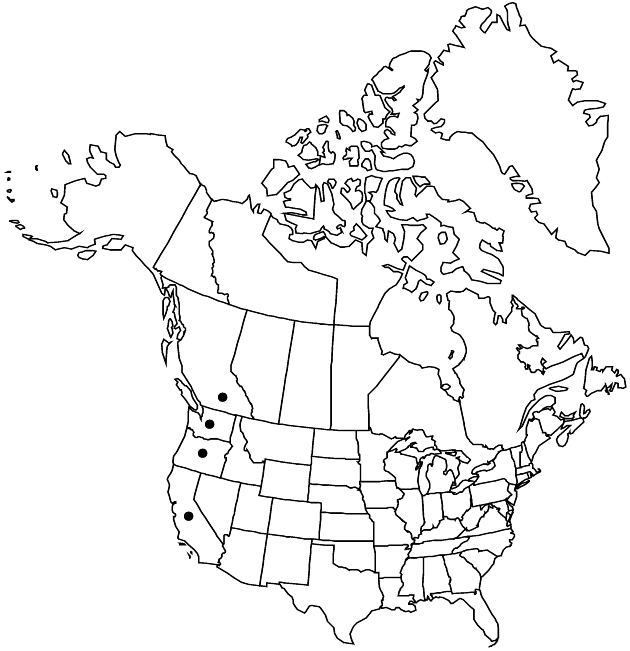Eurybia radulina
Phytologia 77: 261. 1995.
Plants 10–70 cm, laxly cespitose (grayish green), eglandular; rhizomes elongate, slender, woody. Stems 1–3, ascending to erect, often purple, simple, flexuous, proximally glabrescent or sparsely villous, distally ± densely villous. Leaves cauline, firm, margins slightly revolute, coarsely serrate or (distal) entire, scabrous to strigoso-ciliate, teeth mucronate, ± markedly veined, apices mucronate, abaxial faces scabrous, adaxial scabroso-strigose; proximal mostly withering by flowering, petioles winged, shorter than blades, bases clasping, blades elliptic to obovate 12–45+ × 7–20+ mm, smaller than mid, apices obtuse; mid narrowly winged-petiolate (petioles short with ± clasping bases), distally subpetiolate or sessile, blades ovate or elliptic to broadly oblanceolate or obovate, 32–85(–130) × 4–40 mm, gradually reduced distally, bases usually attenuate, sometimes cuneate, apices obtuse to acute; distal (arrays) oblanceolate to lanceolate, 5–28 × 1–8 mm, more sharply reduced. Heads 5–30+ in flat-topped, corymbiform arrays. Peduncles densely villous; bracts 0–1, scabroso-strigose. Involucres campanulate, 6–9 mm, shorter than pappi. Phyllaries 38–62 in 4–5 series, midnerves slightly raised (outer), oblong (outer) to lanceolate-linear or linear (inner), unequal, membranous, bases indurate, ± rounded, green zones to scarious margins in distal 1/3–1/2 (outer; seldom ± wholly foliaceous) to 1/5 or none (inner), margins often purple, hyaline, narrowly scarious, erose, densely villoso-ciliate, apices appressed, sometimes purplish-tinged, usually acute, sometimes obtuse, adaxial faces villous. Ray florets 10–15; corollas white to sometimes pale violet or purple, 8.5–11(–13) × 1.3–2.3 mm. Disc florets 30–70; corollas yellow becoming purple- or pinkish-tinged, 6–7(–8) mm, ± ampliate, tubes equaling to longer than funnelform-campanulate throats, lobes usually erect, sometimes ± spreading, lanceolate, 1–1.3 mm. Cypselae tawny, fusiform, 3–3.5 mm, slightly compressed, ribs 7–9 (brown, translucent), faces strigillose; pappi of tawny bristles 2.7–3 mm, ± equaling disc corollas. 2n = 18, 27.
Phenology: Flowering summer.
Habitat: Dry rock outcrops, edges of forests, open forests, mostly on slopes, foothill oak woodlands, oak, oak-fir, yellow pine forests
Elevation: (10–)100–1600 m
Distribution

B.C., Calif., Oreg., Wash.
Discussion
Eurybia radulina is confined mostly west of the Cascades, from southern Vancouver Island (British Columbia) to the southern Coast Ranges, north Channel Islands, and central Sierra Nevada in California. It often is confused with E. merita in the western, coastal states where both are found, though populations are rarely if ever sympatric, the former apparently thriving at lower elevations than the latter.
Selected References
None.